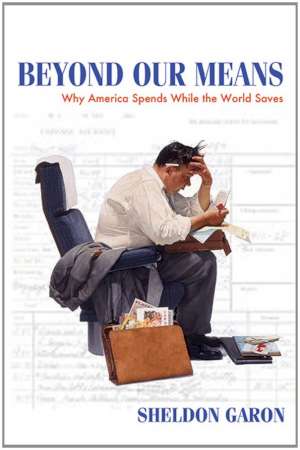01 July 2012
Beyond Our Means
Why America Spends While the Rest of the World Saves
Sheldon Garon
2011, Princeton University Press, 448 pages, £19.95
ISBN 9780691159584
Reviewer: Stephen King, Group Chief Economist, HSBC

This is a curious book. You might think from its title that it offers a story about global imbalances: why, for example, the US persistently runs a balance of payments current account deficit while the likes of China, Russia, Saudi Arabia, Germany and Japan run surpluses. It doesn’t. Instead, as the author notes in his introduction, “We are concerned here with the history of ‘small saving’ and ‘small savers’.”
The book is much more about the differences in attitudes to saving over hundreds of years across both countries and continents. Garon distances himself from both standard economic theories based on ‘rational man’ and the theories of behaviourists who, he thinks, are more interested in human beings in general than in the specific national characteristics of Americans compared with, for example, the Japanese or French. Garon prefers to focus instead on moral suasion and its influence on institutional differences between nations. What role did Calvinists play in encouraging saving in the 19th Century? Why did post office savings become so popular in the UK and Japan yet fail to become properly established in the US?
There is plenty of interesting stuff here. Daniel Defoe advised tradesmen to pursue “prudent management and frugal living.” Benjamin Franklin - perhaps the most famous advocate of saving and, it turns out, a Defoe disciple - warned that, “The Borrower is a Slave to the Lender, and the Debtor to the Creditor,” an aphorism that sums up the Eurozone’s current woes remarkably well. We learn about the advent of mass production in the US in the 1920s and the associated growth of consumer instalment credit.
However, the book also has its limitations. Had it been published in the 1980s, it would undoubtedly have struck a chord because Garon knows a great deal about Japan and has written extensively on Japanese savings behaviour. He devotes only a handful of pages, however, to Chinese savings behaviour, even though the Sino-American savings imbalance is, politically at least, a far bigger issue today.
While he is keen to discuss in detail what might loosely be described as American savings exceptionalism, Garon is less convincing about the UK, a country which embraced American-style consumerism in the 1980s despite an earlier rich tradition of saving. Why was the shift in the UK so big? Why did tradition count for so little? Nor does he have much to say about the extraordinary increase in cross-border savings flows. The Germans may be more frugal than the Greeks but if Germany’s current account surplus is recycled into southern European government debt - as it was pre-crisis - might such frugality ultimately be self-defeating?
There is, ultimately, no proper investigation of whether thriftiness is, in itself, a good thing. While it is certainly true that governments can persuade citizens to save during wartime - suggesting that it might be possible to raise savings during peace-time as well - it is not obvious that a high rate of saving always adds to economic welfare. We may all worry about the lack of American saving - both in the private sector and, more recently, in the public sector - but the US remains the most powerful economy on earth, seemingly able to tap into others’ savings at will.
